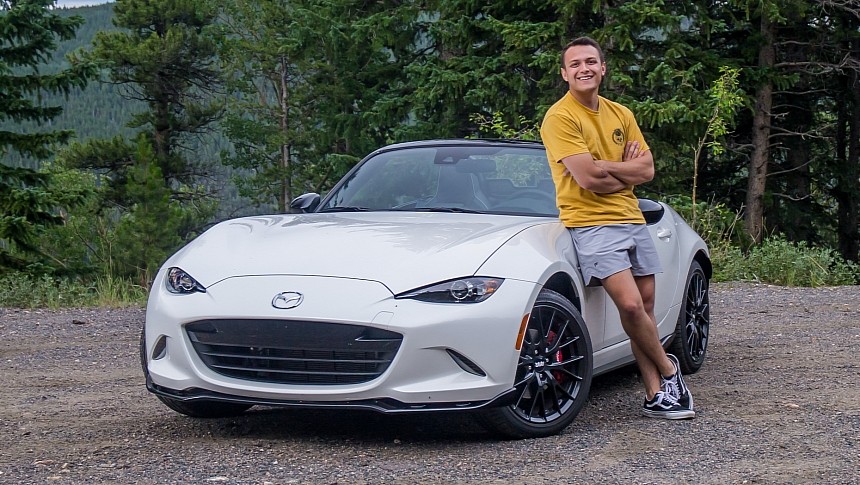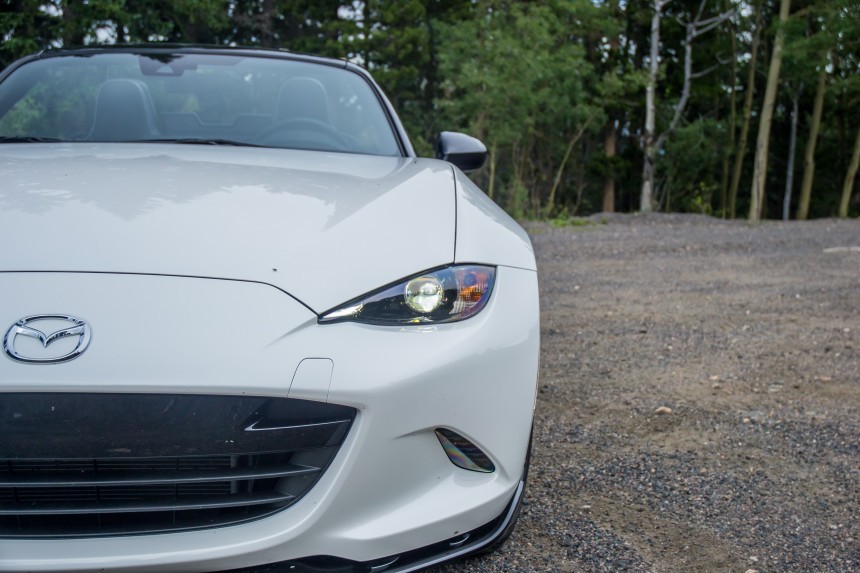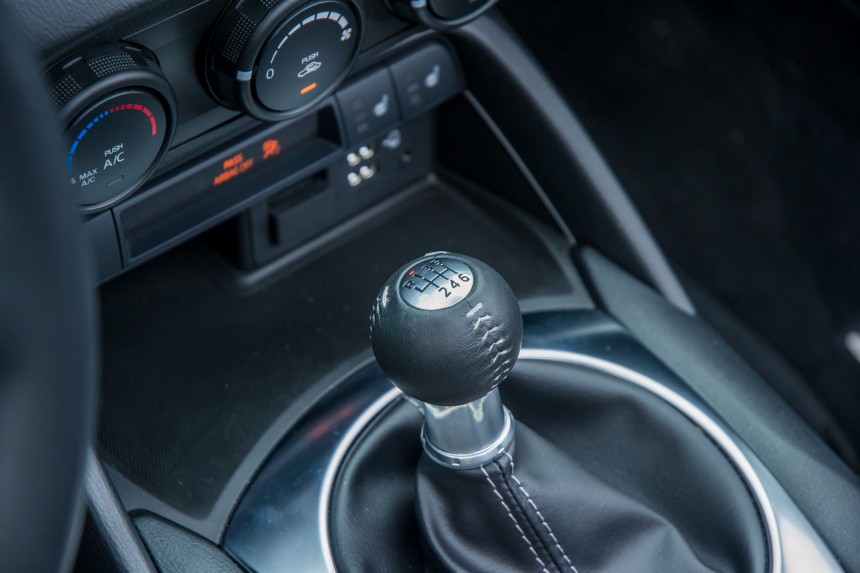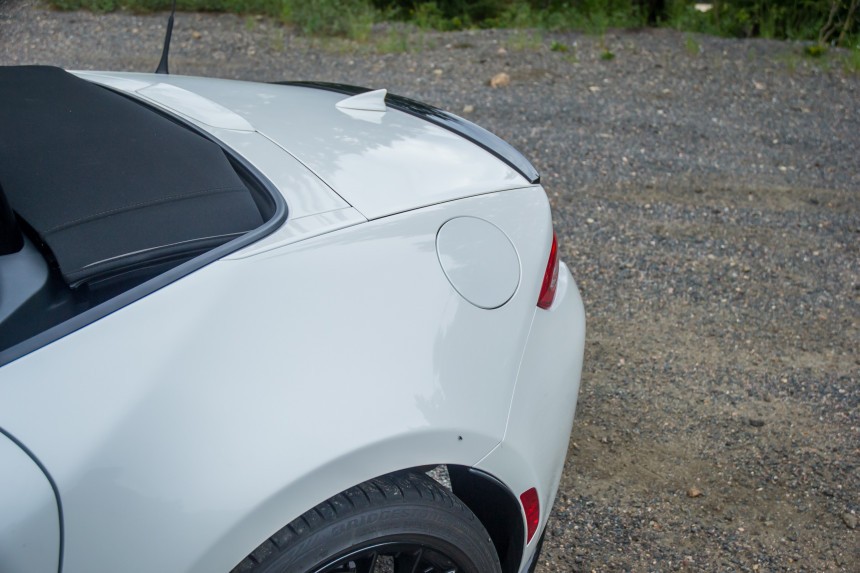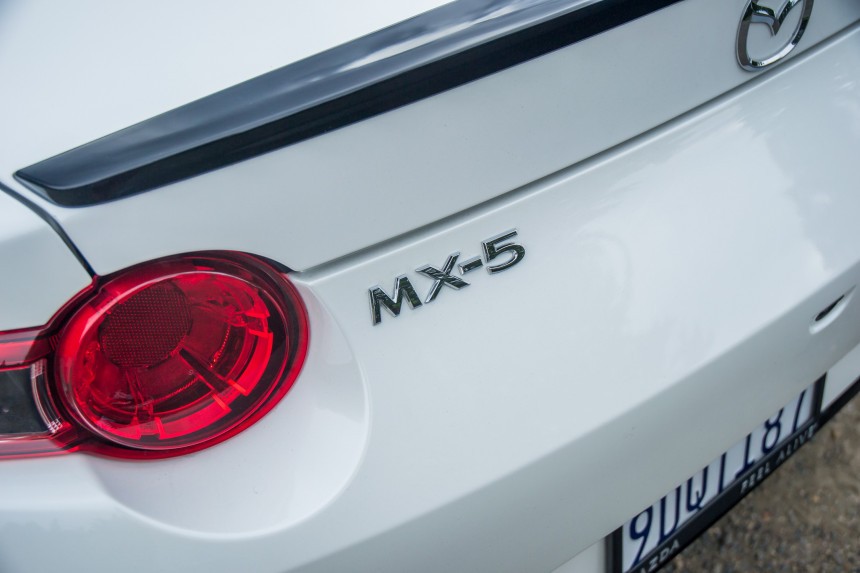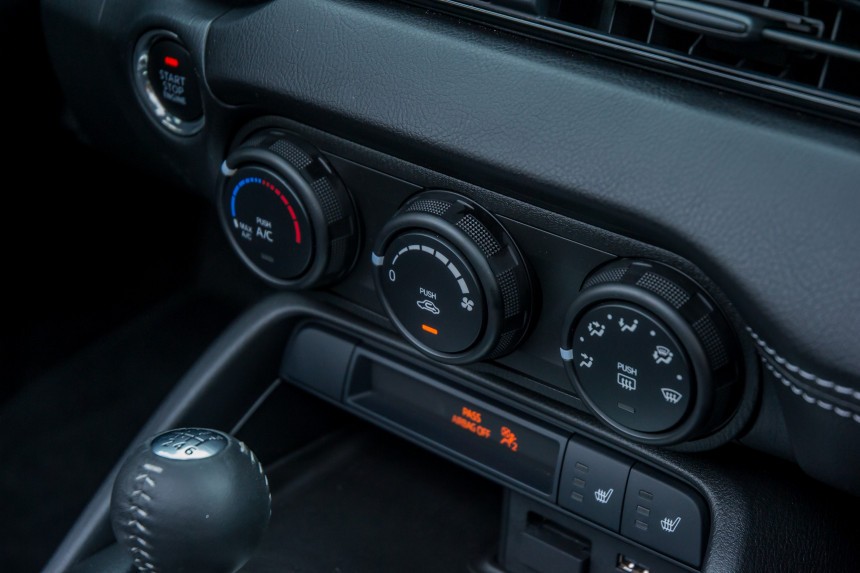In the last two years, I have driven the new BMW M2, the Toyota GR86, the Nissan Z, the Toyota GR Corolla, the Mini Cooper S John Cooper Works, the Mercedes-AMG A35, the BMW M240i, the Honda Civic Si, an Audi RS6 Avant, and my own 986 Porsche Boxster and E46 BMW M3. I say this not to brag about my job or my personal garage, which these reviews can come across as, but I say this because a single car serves as a benchmark for all of them.
It feels impossible to say something new about the current ND-generation Miata, or the Japanese roadster on the whole. Hopefully, we get close over the next 2,000 words. After a light update that pushed power to 181 horses in 2018, I’d argue the Mazda Miata is right where it needs to be. The little power bump, from some 150 or so horsepower, wasn’t entirely necessary. But it did add some urgency, and the RF trim introduced with the ND also adds some year-round comfort for those looking to daily drive the car.
But regardless of updates, the Miata has shown incredible clarity of vision over the last couple of decades. Only 99 pounds heavier than the original NA, it remains a lightweight unfussy sports car that is both more capable and more fun than you’d ever imagine if you hadn’t driven one. For that reason alone, the current Miata is my benchmark. If a sports car can attain Miata-like status in some small way, whether it is in the way it drives or the way it makes me feel, I’m more likely to view it favorably.
Still, I love a good soft top, and this Club car with the BBS/Brembo/Recaro package (more on this later) is a great, clean design that doesn’t do too much. It’s important to have the roofline both work with and without the roof on a convertible, otherwise, things look a little awkward- I don’t like 911 Cabs for this reason. The Miata nails that, and with next to no aesthetic updates since 2016, the shape is familiar, and by no means unwelcome. I’ve never been 100% sold on the car’s squinty lighting, but modern light technology means they can be very small indeed. I just tell myself it saves weight.
I refute my own point there because sitting there with the 10-year-old infotainment and nowhere to put a cell phone, you will too. That’s because the little things add up. Mazda’s own David Coleman, an engineer who worked on the ND, pointed out to me that your feet line directly up with your shoulders. It’s a small detail, but big at the same time. So too is the pedal placement, which is so perfect I can’t help but wonder why Toyota let Quasimodo set the pedal placement on the GR86 and GR Corolla. In short, where this interior lacks features, it makes up for it in ergonomics. See also, movable cupholders.
Storage is obviously poor. Yes, the cupholders are nice, and the over-the-shoulder glovebox is shockingly deep. There are some clever pouches in the backing behind the seats too. But it ends there. Many things were improved from the NC to the ND, but removing that car's netted door pockets feels like an oversight. At least with one on the transmission tunnel, you’d have somewhere to put a phone.
I harp on this because the infotainment system is best when it is used with Carplay or Android Auto, which you’ll need a USB for if you own an Android. What with the battery toll wireless projection takes, Apple users will need somewhere to charge too, and running a USB from the center stack all the way back to the glovebox is annoying.
But that’s all nitpicking. The Miata’s interior is genuinely nice for the money. There’s very little crappy plastic, and both the stock and Recaro-branded seats feel premium and comfy. The leather on the wheel feels above this price point, and nothing feels cheap to handle or touch. This interior continues the remarkable clarity of vision that I so admire the Miata for.
Really, a million little things add up to the way the Miata drives. Take, for example, the car's light weight and lighter flywheel. On some surfaces, I can let the clutch out without applying throttle and the car will roll forward. Heel-toe downshifts are fast and easy thanks to straightforward ergonomics and a light flywheel, paired with one of the great modern gearshifts. I could go on. Let’s, on second thought. The tires are skinny, and the 215-section tires let you slide the car around without feeling like you’re endangering yourself. This can be an educational experience if you’re smart enough to learn from what the fantastic chassis tuning and clear-as-day controls feedback are telling you.
The engine didn’t need more power, but 181 feels like just enough here, especially because third now flirts with reckless driving charges in most states. I’ll be genuinely upset if the Miata becomes more powerful. I love the sound of it too, and the little huffs of air running through the engine can be heard on downshifts. It isn’t sonorous, but the Miata is honest, and no noise feels fake or intentionally manufactured. I actually now prefer it to my Boxster’s flat-six noise, which was the last vestige of preference I held for that car. The Miata has ruined my own small, light roadster for me.
Funny thing is, anyone reading this likely already knows all that. These things are quintessentially Miata. And that hasn’t changed for 20 years. While I’m sure my writing professors would be stoked I keep looping back to the overall theme of this story, it really does make a difference to have these traits be so omnipresent in the Miata lineup.
I can’t feed you anything revolutionary about the way the Miata drives. It drives like a Miata. And the fact that this has become a byword for the kind of driving experience enthusiasts want is a feat on its own.
It has a very, very small trunk, but I don’t notice, even at 4.6 cubic feet. It holds groceries great, and I fit mine and my girlfriend’s luggage in a Miata on returning from a week in Hawaii. Now, obviously, some investment is required to carry more. RF models are great candidates for bike racks, and Mazda will sell you a tow hitch for a rack too. I suppose you could tow, which may be useful to carry tools to and from the track- but capacity is just 400 or so pounds.
The Miata’s small size makes it a joy to park. I can see the tops of the fenders and the curb in the rearview mirror, making parallel parking in the city a breeze. It also has a great turning radius, another bonus for city living. I’ve also heard these do well in the snow, and I’d love to have the Miata back come winter for some snow testing.
But the combination of a small motor and light weight also means fuel economy is a very un-sporty 37 mpg. I saw that figure, combined, with 700 or so miles of city, highway, and at-pace driving. Often, I’d go hit the canyons, watch the average dip to around 29 mpg, then see it slowly creep back up as I made my way home at more civil speeds. I would also do this multiple times over the course of my loan, something I’ve only done with a small group of other sports cars. Once work was done, it was time to go slide the Miata around and learn what it would teach me about lift-off oversteer, on-limit braking behavior, and understeer.
I still think if you’re looking to daily drive a Miata the RF is the way to go. It’s just a quieter car to live with. But the soft top was quieter by a noticeable amount compared to my Boxster, which is actually a very refined thing on the highway. There is noise from the tires, but this is by no means permission to go tell your dealer the Miata is too loud. It isn’t. I won’t when I buy one.
Really, that’s all that needs to be said here. The Miata remains one thing: an affordable, usable car that is still better to drive than larger competitors like the BRZ/86, and yet is just useful enough for a car-obsessed person such as me to justify buying it. To boot, I made it all the way through this review without the tired “Miata is the answer” cliche, which I’m actually very proud of.
But regardless of updates, the Miata has shown incredible clarity of vision over the last couple of decades. Only 99 pounds heavier than the original NA, it remains a lightweight unfussy sports car that is both more capable and more fun than you’d ever imagine if you hadn’t driven one. For that reason alone, the current Miata is my benchmark. If a sports car can attain Miata-like status in some small way, whether it is in the way it drives or the way it makes me feel, I’m more likely to view it favorably.
Design Evaluation
Speaking of viewing things, the Miata’s aesthetics have changed quite a lot across its different generations. A Porsche 911 this is not. Each of these iterations has its highlights- I love the retro looks and clean lines of the NA, the sleek face of the NB, the flared arches of the NC. But the ND stands out the most, arguably because of the RF trim, which this car is obviously not. Flying buttresses are always a winner in my book.Interior Assessment
I tell that to myself when I sit down in a Miata too. There’s not much going on, and that feels refreshing when compared to other sports cars. Hell, it feels refreshing compared to just about anything new. Still, if you can fault the Mazda Miata, here is where it can be done. See, this Club car, options, delivery, and all, costs $37,510. It still has manual, single-zone climate control and the infotainment system must be at least a decade old. Now, much like some other cars at this price point (GR86, etc.) you can argue the money goes to the performance, and you’d be right. Making a car that sits on an in-house chassis in 2016 that weighs just 2,341 lbs. costs money.I refute my own point there because sitting there with the 10-year-old infotainment and nowhere to put a cell phone, you will too. That’s because the little things add up. Mazda’s own David Coleman, an engineer who worked on the ND, pointed out to me that your feet line directly up with your shoulders. It’s a small detail, but big at the same time. So too is the pedal placement, which is so perfect I can’t help but wonder why Toyota let Quasimodo set the pedal placement on the GR86 and GR Corolla. In short, where this interior lacks features, it makes up for it in ergonomics. See also, movable cupholders.
I harp on this because the infotainment system is best when it is used with Carplay or Android Auto, which you’ll need a USB for if you own an Android. What with the battery toll wireless projection takes, Apple users will need somewhere to charge too, and running a USB from the center stack all the way back to the glovebox is annoying.
But that’s all nitpicking. The Miata’s interior is genuinely nice for the money. There’s very little crappy plastic, and both the stock and Recaro-branded seats feel premium and comfy. The leather on the wheel feels above this price point, and nothing feels cheap to handle or touch. This interior continues the remarkable clarity of vision that I so admire the Miata for.
Driving Take
If you want to go driving in the Miata, the Club trim is the one to have. You’ll get a limited-slip diff, Bilstein suspension, and some other goodies. It’s also imperative to spec the $4,500 Brembo/BBS/Recaro pack. That adds Brembo front brakes that are red (very important) and larger than stock. The rear caliper is also red, but not the caliper carrier bracket, because money. It’s also why the rear brakes don’t change in diameter. The forged BBS wheels are lighter than the stock ones, but I wish you could have them in silver- I’m sick of black wheels. The Recaro seats are fantastic too, and they’re heated for year-round comfort. I also appreciate the extra bolstering over stock, but some lumbar adjustment could be useful here.The engine didn’t need more power, but 181 feels like just enough here, especially because third now flirts with reckless driving charges in most states. I’ll be genuinely upset if the Miata becomes more powerful. I love the sound of it too, and the little huffs of air running through the engine can be heard on downshifts. It isn’t sonorous, but the Miata is honest, and no noise feels fake or intentionally manufactured. I actually now prefer it to my Boxster’s flat-six noise, which was the last vestige of preference I held for that car. The Miata has ruined my own small, light roadster for me.
Funny thing is, anyone reading this likely already knows all that. These things are quintessentially Miata. And that hasn’t changed for 20 years. While I’m sure my writing professors would be stoked I keep looping back to the overall theme of this story, it really does make a difference to have these traits be so omnipresent in the Miata lineup.
I can’t feed you anything revolutionary about the way the Miata drives. It drives like a Miata. And the fact that this has become a byword for the kind of driving experience enthusiasts want is a feat on its own.
Everyday Living
This segment comes with a caveat. I’m a 26-year-old male living in a medium-sized city. The most I have to transport is my partner, or maybe a bike. Sometimes my friends can stomach my constant blabbing about cars long enough to be in one with me. So, the Miata fits my needs just great.It has a very, very small trunk, but I don’t notice, even at 4.6 cubic feet. It holds groceries great, and I fit mine and my girlfriend’s luggage in a Miata on returning from a week in Hawaii. Now, obviously, some investment is required to carry more. RF models are great candidates for bike racks, and Mazda will sell you a tow hitch for a rack too. I suppose you could tow, which may be useful to carry tools to and from the track- but capacity is just 400 or so pounds.
The Miata’s small size makes it a joy to park. I can see the tops of the fenders and the curb in the rearview mirror, making parallel parking in the city a breeze. It also has a great turning radius, another bonus for city living. I’ve also heard these do well in the snow, and I’d love to have the Miata back come winter for some snow testing.
But the combination of a small motor and light weight also means fuel economy is a very un-sporty 37 mpg. I saw that figure, combined, with 700 or so miles of city, highway, and at-pace driving. Often, I’d go hit the canyons, watch the average dip to around 29 mpg, then see it slowly creep back up as I made my way home at more civil speeds. I would also do this multiple times over the course of my loan, something I’ve only done with a small group of other sports cars. Once work was done, it was time to go slide the Miata around and learn what it would teach me about lift-off oversteer, on-limit braking behavior, and understeer.
Test Drive Roundup
I always say that when a good car leaves. “One day…” as it rounds the corner and dips out of sight. I said it with the Civic Si and a handful of others. But with the Miata I meant it. I’ll sell my Boxster sometime next fall, and ideally, by then I’ll have found my ideal spec: a Soul Red Crystal RF with the Brembo/BBS/Recaro pack.Really, that’s all that needs to be said here. The Miata remains one thing: an affordable, usable car that is still better to drive than larger competitors like the BRZ/86, and yet is just useful enough for a car-obsessed person such as me to justify buying it. To boot, I made it all the way through this review without the tired “Miata is the answer” cliche, which I’m actually very proud of.
Pros
- Maybe the best six-speed in a series production car on sale today
- Classic driving dynamics still worthy of praise 20 years on
- It’s still just 2,300 pounds
- Cliches exist for a reason
Cons
- I guess they cost money?
- Infotainment just needs to be a touchscreen at this point
- Where am I supposed to put my phone?
- Why is there not a government incentive for first-time Miata buyers?
